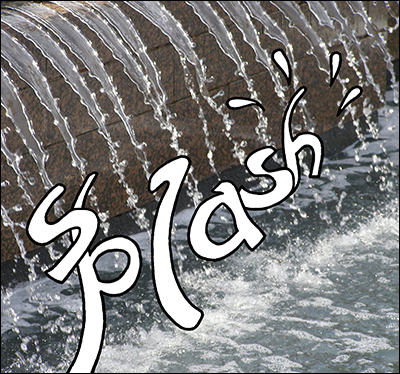



Navigation: Organic Language, Part-1-extra (this page), Part-2-extra, Part-3-extra
The word drawings in Part 1 of ‘Organic Language’ should be pronounced aloud and slowly. Follow the contours of the drawings with your voice. Repeat each word until you can feel the sound move through the tissues of your upper body.
The drawings demonstrate the importance of bodily sensation in speaking and hearing words, and deriving meaning from them.
Other features of language that can be observed include:
1. The vast difference between the spoken word and its two-dimensional representation in traditional printing.

Say the word ‘Sweep’ out loud and slowly. Follow the contours of the drawing with your voice. Visualise your tongue as it makes the ‘s’. Feel the air spilling over your lower lip, like the clouds of dust in the picture. As you say the ‘-weep ’, feel the sound rise to your top lip, gum ridge and the maxilliary sinuses (in the bone above the top jaw). Repeat the word and sustain the ‘ee’ again. Press your finger against your cheek until you can feel the outline of the root of a canine tooth. Feel the vibration happening in your upper jaw and the sinus above. |
|
2. Rendering speech into writing removes many of the fundamental features of speech and moves words out of their natural realm of 4-dimensional sound, into a flat, 2-dimensional, visual-spatial realm.1* |

Look at a printed version of the word ‘Sweep’. You might imagine reading a written message asking you to: ‘Sweep the floor.’ As you read, ideas and images assemble in your brain. The word ‘Sweep’ is there, but it is reduced to an intellectual concept, a task to be performed. The multi-sensory nature of the word has been turned into a flat, intellectual concept. You can of course read the sentence out loud and put all that dynamism and feeling back into the word ‘Sweep’. But we are so used to reading silently, that we read and extract the bare intellectual meaning without a second thought. |
|
Writing presents a sequence of visual cues from which a reader recreates spoken words. Whilst the visual image of a printed word enters the brain via the eyes, it has to be passed to the hearing-speech area of the brain for meaning to be derived from it.2* |
|
3. Mechanisms by which vocal sound evokes meaning. |
|
Part 4 of ‘Organic Language’ examines this subject in detail. A couple of points of note are given here. |

Immitating sound from our environment is a fundamental means by which vocal sound can convey meaning. Words like ‘Bang!’, ‘Crash!’ and ‘Splash!’ are vocal mimics of naturally occurring sounds. Because they aim to be a direct copy of the natural sound they are called ‘iconic’ (also know as onomatopoeia). |

Now think of the word ‘flash’. If you think of the shapes of the mouth and the movement of sound as you pronounce the word, it is very similar to ‘splash’. But whilst a ‘splash’ puts out a sound, a ‘flash’ is just a sudden appearance of light — there is no sound. With the word ‘flash’, vocal sound is used to imitate a phenomenon of light. When a stimulation of one human sense produces a perception in another sense, we call the effect ‘synaesthesia’. So an apt term for describing the cross-sensory nature of words like ‘flash’ is ‘synaesthetic iconism’. |

Look at the word ‘Bay’: Prolong the vocalisation of the ‘ -y...’ Follow the curve in the drawing by swerving your jaw from one side to the other. Feel the sound make the shape of a curved recess. This is ‘synaesthetic iconism’. Many of the words in the first part of ‘Organic Language’ exhibit this quality. |
* * * * *
1. Ong, Walter J. 1982, Orality and Literacy, Methuen, London, p.12: "Though words are grounded in oral speech, writing tyrannically locks them into a visual field forever." (Back)
2. Ong, Walter J. 1982, Orality and Literacy, Methuen, London, p.8: "Written texts all have to be related somehow, directly or indirectly, to the world of sound, the natural habitat of language, to yield their meanings. 'Reading' a text means converting it to sound, aloud or in the imagination ... " (Back)
* * * * *
Links
Organic Language
Organic Language Part 1 extra (this page)
Organic Language Part 2 extra
Organic Language Part 3 extra